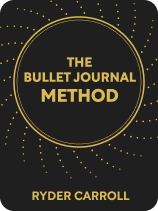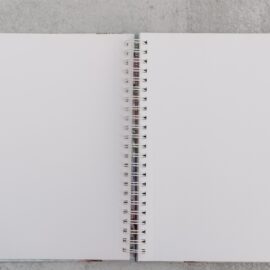

This article is an excerpt from the Shortform book guide to "The Bullet Journal Method" by Ryder Carroll. Shortform has the world's best summaries and analyses of books you should be reading.
Like this article? Sign up for a free trial here .
Are you looking for The Bullet Journal Method book review? How did Ryder Carrol come up with his bullet journaling method?
After years spent perfecting his own organizational techniques, author Ryder Carroll devised the Bullet Journal Method. After realizing the method’s potential to help others, he decided to formalize it, streamline it, and release it to the public.
Here’s our review of the book The Bullet Journal Method.
About the Author
Ryder Carroll is a digital product designer from New York. Throughout his career, he’s worked with notable companies such as Adidas, American Express, Cisco, IBM, Macy’s, and HP.
After he was diagnosed with learning disabilities in high school, Carroll was determined to find a strategy to improve his focus and productivity. Following years of trial and error, he used his experience with scrapbooking, journaling, and web design to develop what he called the Bullet Journal Method. Although Carroll initially kept the method to himself, he later streamlined it and introduced it to the public through a website launch in 2013.
After the site went viral, Carroll’s method rose in popularity and was featured by the New York Times, the LA Times, Forbes, the Wall Street Journal, the BBC, Vogue, Fast Company, and Bloomberg, among others. When he realized just how much it had impacted people’s lives, he decided to write a book, The Bullet Journal Method, to demonstrate how you can use the method to tackle not only productivity but also many other of life’s biggest challenges.
Connect With Ryder Carroll:
Bullet Journal Social Accounts:
The Book’s Publication
Publisher: Portfolio, a division of Penguin Random House
The Bullet Journal Method was Carroll’s first (and, thus far, only) book. It was published in 2018 following the success of the launch of the Bullet Journal Method website. Carroll wanted to write a book to explore how to use the method as a practice in mindfulness and intentionality rather than just productivity.
Intellectual Context
While the Bullet Journal Method is a unique system, its usefulness arguably stems from the way it combines many journaling and productivity tools into one streamlined method. To take full advantage of the method’s customizability, Carroll recommends that readers call on existing resources such as lists, calendars, schedules, habit trackers, gratitude logs, and creative journaling.
In addition, although Carroll dedicates a large part of the book to the Bullet Journal Method itself, he also pulls from a variety of philosophies to explore how the method can help you overcome challenges like maximizing time, cultivating gratitude, and letting go of what you can’t control. In particular, Carroll references the Greek and Greco-Roman philosophies of Eudaimonism and Stoicism, the Japanese concepts of ikigai and kaizen, and problem-solving techniques like sprints and rubber ducking from the field of software development.
The Book’s Impact
Given that the Bullet Journal Method was already popular before The Bullet Journal Method’s publication (having already garnered significant followings on Instagram, Facebook, Pinterest, and YouTube), the book was well-received, which helped extend the method to an even wider audience. It became a New York Times and international best seller and has been published in more than 28 languages. In addition, following the book’s publication in 2018, there was not only an 18% increase in the sale of unruled notebooks in the US from the year before but also a significant growth in the sale of other stationery products.
Critical Reception
The Bullet Journal Method book reviews praise the method’s value to both those who are new to it as well as those who consider themselves veterans. This is because the book covers not only the system itself but also ways you can use it to improve your life.
Overall, reviewers agree that The Bullet Journal Method provides valuable insight
As for the book’s general audience, those who enjoyed it agree that reading it would benefit everyone interested in productivity and self-improvement, whether or not they’ve used the Bullet Journal Method before. They praise how the book utilizes anecdotes and data to back up the author’s claims as well as useful diagrams to demonstrate how the method works. Additionally, they like that the book focuses on both how and why to use the method. Overall, they feel that it helped them reconnect with what truly matters to them.
On the other hand, critics of the book think it focuses too heavily on self-improvement and too lightly on the details of how to use the method. In addition, they claim the book is poorly written and that the author’s recommendations are weak and easily discernible without the help of his book. Moreover, some artistically-inclined readers say the book fails to provide creative inspiration.
Commentary on the Book’s Approach
Carroll’s demonstration of the Bullet Journal Method system and how to customize it is effective. He consistently pairs written descriptions of the system with relevant examples, visual aids, and diagrams that help clarify any uncertainty about how the method works. One potential exception is Carroll’s description of “threading,” a technique that’s supposed to reduce the time you spend searching for pages of related content. Even with a visual aid, it’s difficult to grasp how to implement the technique.
Meanwhile, Carroll’s discussion of how to use the Bullet Journal Method to increase productivity and improve your life has positives and negatives. On the one hand, his anecdotes and references add credibility to his ideas and make compelling arguments for why you should use his method. For example, in the section titled “Imperfection,” Carroll first introduces the Japanese concept of wabi-sabi (beauty is found in imperfection), as well as the Japanese culture’s focus on mastery over perfection, to inspire readers to see themselves and their efforts in a different light that eschews perfectionism. Then, he provides an immediate opportunity for application by describing how readers can implement these ideas into their Bullet Journal practice.
On the other hand, Carroll’s flow of ideas tends to meander and repeat, making it somewhat difficult to identify his main point. For example, in the section titled “Meaning,” Carroll alternates between the idea that we’re searching for fulfillment in the wrong places and the idea that we can find happiness by doing what’s meaningful. In doing so, he ultimately buries the main point—that fulfillment comes from doing what we find worthwhile. While readers may eventually deduce Carroll’s primary idea, the structure of his argument makes reaching this conclusion burdensome.
Commentary on the Book’s Organization
At surface level, the book’s organization is logical. Carroll divides it into parts that establish a foundational understanding of the Bullet Journal Method before exploring how to make the most of the practice. Specifically, he ensures that readers grasp the basic components of his method before diving into how they can tailor their journals to their needs.
However, some of Carroll’s within-part organizational choices interrupt the flow of his ideas. For example, in Part 1, although he begins intuitively by discussing how he developed the Bullet Journal Method, why readers should use it, and what to expect from the book, the organization then becomes less coherent. Instead of exploring how to get started, he backtracks to provide additional justification for why you should use his method. Then, he changes topic twice more by introducing a mind-decluttering exercise before discussing why notebooks are fundamental to Bullet Journaling and how handwriting is beneficial.

———End of Preview———
Like what you just read? Read the rest of the world's best book summary and analysis of Ryder Carroll's "The Bullet Journal Method" at Shortform .
Here's what you'll find in our full The Bullet Journal Method summary :
- A comprehensive guide to using the Bullet Journal Method
- How to maintain a journaling practice that can improve your overall quality of life
- How to extend the method beyond productivity to a practice in mindfulness






